MFN Anniversary stamp block
As with every MFN lustrum, we have again had a small present made for all members. This time something really philatelic: a block with 3 different personal stamps, enclosed in newsletter 141 (September 2022).
Now you may think: that is not possible, 3 different stamps in 1 sheet? That is indeed not possible in the Netherlands (unless you order at least 1000 sheets, but the MFN does not have that many members). But with some searching we found that it is possible in Liechtenstein, with a minimum purchase of only 6 sheets.
By the way, you can also have sheets made there with 8 hexagonal stamps, each with a different image, and so-called "panorama sheets" where 1 large image is printed over a sheet with 5x2 stamps. So a lot of possibilities for such a small country. If you want to know more about this or get started with it yourself, check out the website: diemarke.li.
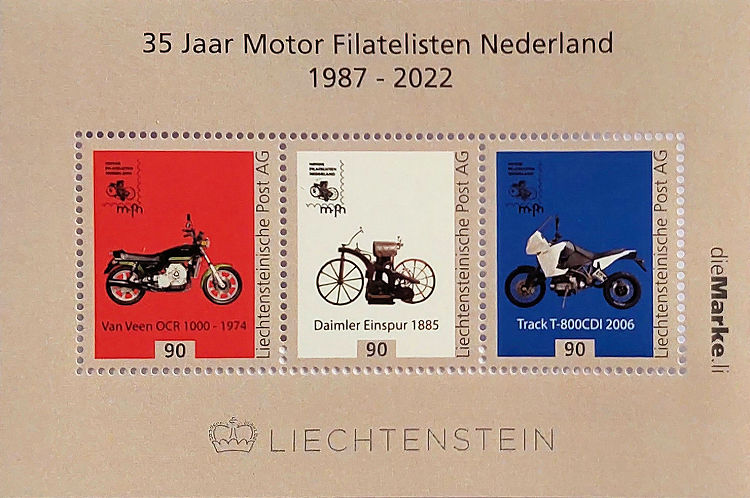
Of course those three stamps had to be filled with nice images of motorcycles! The first was quickly decided: the Daimler Einspur, which has been part of our club logo for 35 years, and can therefore be found on the newsletter, the website, the promotional stamps and the banners.
Because we are a Dutch club, we preferred Dutch motorcycles on the other stamps. Now PostNL (finally!) issued stamps with images of Dutch motorcycles on them last year, and we didn't want to repeat that. Fortunately, in more recent motorcycle history, a few Dutch-made motorcycles have also appeared.
To emphasize the Dutch aspect, the colors of the Dutch flag (red - white - blue) have been chosen for the background. Fortunately rotated 90°, this prevents discussions about whether or not to support the farmers' protests for which the flag is put upside down (which only started long after the moment of designing the block....).
The first will be familiar to most club members: the Van Veen OCR 1000 with Wankel (rotary) engine. This was one of the first true "super bikes". In its day it was one of the strongest and fastest series motorcycles on the market.
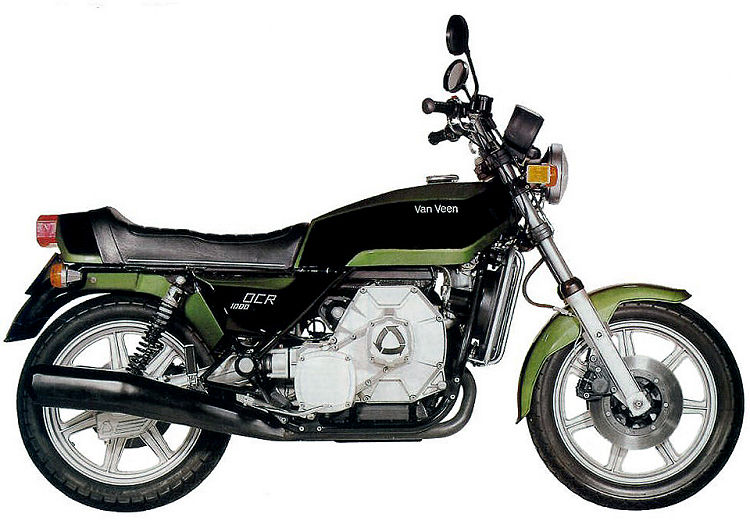
The OCR 1000 was a project of the well-known Kreidler importer for the Netherlands: Henk van Veen, also the man behind the racing successes with the Kreidler Van Veen 50cc racers. He wanted to build the best-of-all motorcycle in 1971, using the best possible techniques and parts.
He was interested in the Wankel or rotary engine that was on the rise at the time. But not a simple air-cooled single-disk engine, like the Sachs engine in the Hercules W2000, it had to be a water-cooled 2-disk engine.
In 1973 a prototype was built based on a Moto Guzzi California, in which an engine from a Mazda RX3 was installed. This didn't look nicely, but that wasn't a problem as the bike was only meant to test the technical principle. During the tests, the installation position of the engine (with the "crankshaft" in the longitudinal direction of the engine) turned out not to be optimal. The engine was also not strong enough to Van Veen's liking.
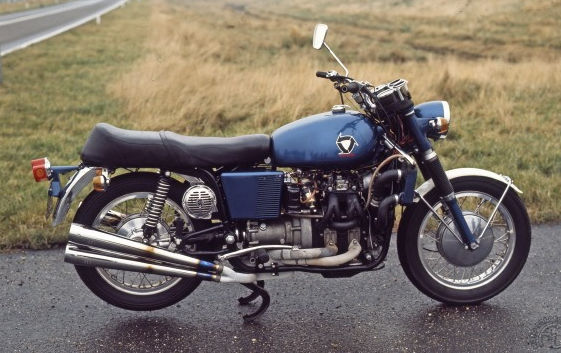
The prototype
Looking for a more powerful engine he heard from NSU about the rotary engine they were developing in collaboration with Citroën, for which a joint venture called Comotor had been formed. This engine was excellent for Van Veen's dream motorcycle.
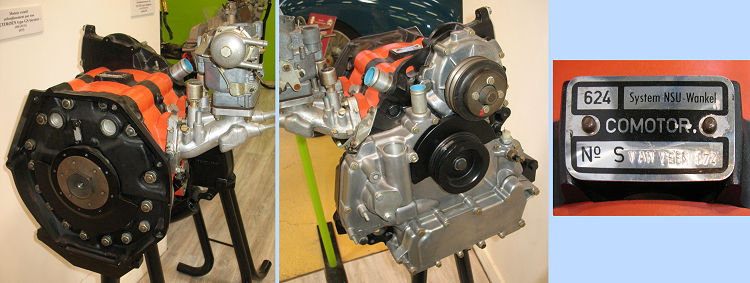
The basis of the engine as produced by Comotor....
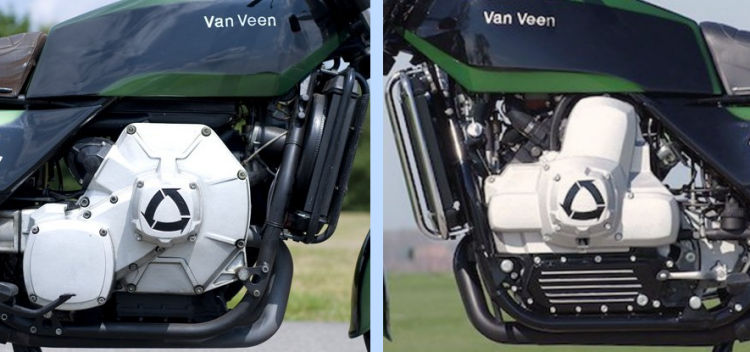
and, almost not recognizable, installed in the OCR1000
The appearance of the motorcycle also had to set new standards. For this, former Kreidler Van Veen driver Jos Schurgers was hired. He managed to create a very modern and timeless design. Even now, almost 50 years after its creation, the OCR 1000 still doesn't look old-fashioned.
When the OCR 1000 was introduced at the 1974 Ifma, 37 orders were immediately registered, although production had yet to start. In the end, the first bike was not delivered until the end of 1977.
All testers were impressed by the bike, especially by the strong vibration-free engine. A 2-disk rotary engine has no less than 6 ignitions per revolution of the crankshaft, just as much as a 12-cylinder four-stroke engine but without the large reciprocating mass of the pistons. Hence the high torque and virtually absent vibrations. People were less enthusiastic about the high weight of well over 300 kg, 150 kg of which is due to the (cast iron) engine block plus gearbox and cardan.
Although the engine was technically and optically successful, it was not a success from a business point of view. Firstly, the price was so high that only few people could afford a Van Veen. The price in 1974 was about 28,000 German marks (€ 14,000), while a BMW R90S Daytona (then one of the top models) cost less than 10,000 marks (€ 5,000).
The biggest problem, however, was that before the delivery of the first OCR 1000 Peugeot, the new owner of the bankrupt Citroën, pulled the plug from the Comotor project. This meant that Van Veen did not get more than the originally delivered batch of approximately 50 engine blocks. Although none of the pre-subscribers canceled their order, there were (almost) no new orders since then. At that time, only just under 40 OCR 1000s had been built (various sources cite different numbers, ranging from 37 to 40).
After the demise of the brand, all remaining parts stocks were bought up, and a few complete motorcycles have been built from this. The exact number of OCR 1000's built is therefore unknown, but there will be a maximum of 45.
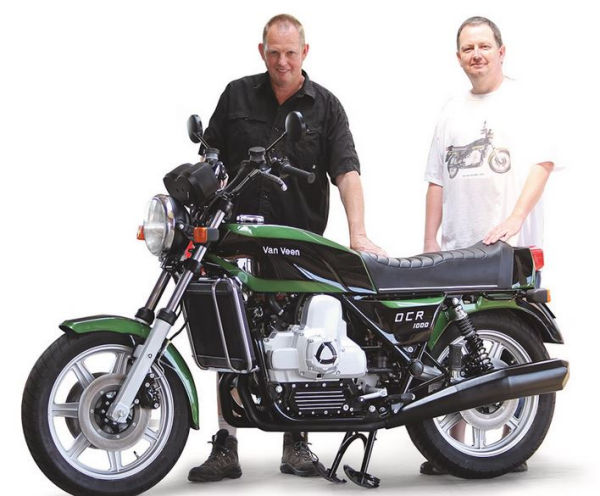
No. 41, built in 2011 from remaining parts
It is clear that this motorcycle is a real classic, for which there is (much) more demand than there is supply. Of course this has consequences for the value of the bike. In 2016, one was auctioned on Catawiki for €80,000, and a later auction in 2019 yielded at least €93,000.

Affordable alternative: bad resembling scale model (1:16)
The third motorcycle is probably much less known. That is the (also Dutch) Track T800-CDI. The letter combination CDI may be familiar to you from the car world, where it stands for Common-Rail Diesel Injection. And indeed, the Track is a motorcycle with a diesel engine!
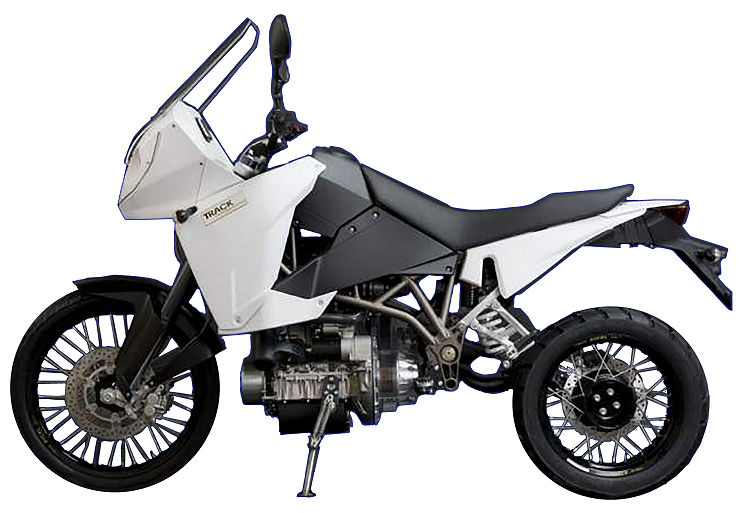
The cause of this unusual choice stems from the previous occupation of Track founder Erik Vegt. He had a company that modified motorcycles for world travelers and rally drivers (EVA Products). Large fuel tanks were always necessary, which make a motorcycle bulky and difficult to handle. Because a diesel uses fuel more efficiently, especially if a high power output is not required, a diesel motorcycle with a much smaller tank could achieve the same range.
A suitable diesel engine was found at Mercedes Benz: the 800cc 3-cylinder turbo diesel that was used for instance in the Smart For-Two. It delivers a modest power of 45 hp (33 kW) at 3000 to 4500 rpm, but an impressive 100 Nm of torque at just 1800 rpm. Consumption is indeed very low at 2.5-3.3 litres/100 km (30-40 km/litre).
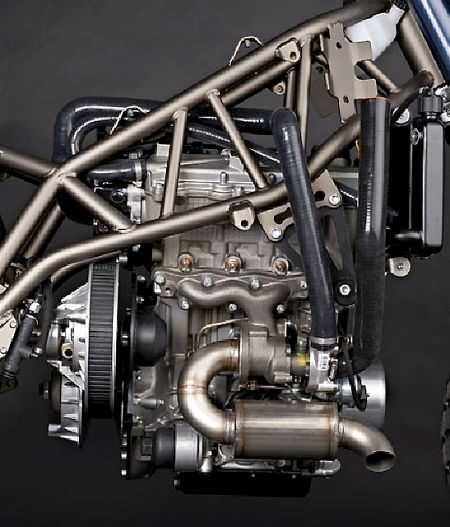
The power pack of the Track
The transmission is by means of a Continuously Variable Transmission (CVT, so automatic) and a drive shaft. That gives the Track an extra Dutch touch, because the CVT is in fact the modernized version of the well-known DAF Variomatic, the "smart shift stick" of the Van Doorne brothers from Eindhoven.
Development of the Track started in 2006, and in 2009 the press had the opportunity to do the first test rides on the bike. In general people were positive about the motorcycle as a travelling bike. Thanks to the CVT and the flat power curve, there was almost always enough power to move smoothly, especially in the most used speed range of 60 to 120 km/h. It is of course not a sports bike.
Handling was also praised. Due to the relatively low weight of 225 kg and the low center of gravity, the motorcycle was easy to handle both in the hand and on the move.
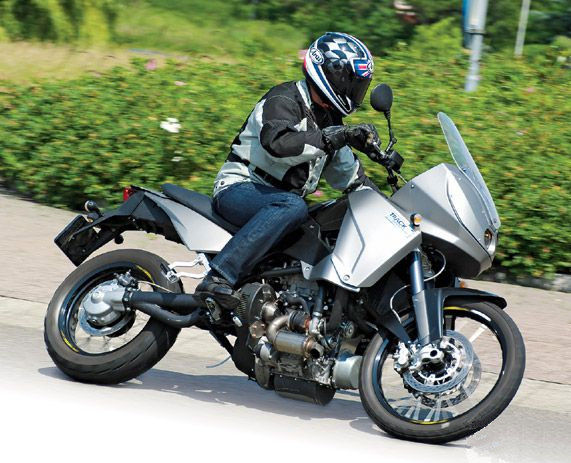
Production stopped in 2013 because some suppliers went bankrupt and there were too few customers to continue production in a profitable way. I have not been able to find out when the first Track was delivered to a customer, nor how many were built. It will not be many, but according to the RDW there were once 12 registered in the Netherlands, and probably some have been sold abroad. So possibly a Track is even rarer than a Van Veen.....
Incidentally, the Tracks in the Netherlands are probably all registered as "homebuild" motorcycle. This because no type approval had (yet) been applied for, that would only happen when the motorcycle was sufficiently developed. Until then, all Tracks have been individually approved, which is normally only done for DIY or highly modified motorcycles.
And speaking of rare: the MFN anniversary block was made in an edition of only 72 pieces. So be careful with it, because it will be a real collector's item!
Paul Essens
Top - Back to former page - Home |